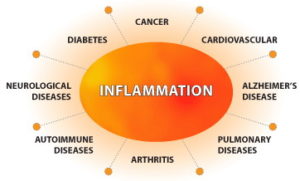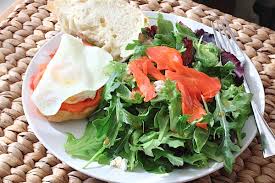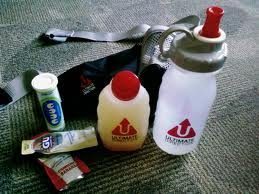Athletes love to work on speed. Some do running intervals, speed sets on the bike and speed intervals in the pool, too. They will hire a coach to help them with a training plan. They may join groups for encouragement and camaraderie. But to run faster, you may need to put some focus into your nutrition, too. Faster running through nutrition is easier to learn when you hire a nutrition coach like me, to help you run, cycle or do any sports faster. You just may need some help making the adjustments quickly in time for your next race.
Faster running can come from nutrition with these 3 key points.
1 — Incorporate an anti-inflammatory diet.
An anti-inflammatory plan will help to lessen inflammation from foods that you eat, toxins you are exposed to on your skin as well as in your environment. But it can also help speed up recovery, lessen aches, pains and stiffness, and improve your energy levels.
Inflammation is not always a bad thing – when you stub your toe, and it swells, that inflammation is part of the healing process and it is good.
But if you have inflammation symptoms including IBS, GI distress, stiffness or pain that lasts for months vs a few days, it is considered chronic inflammation. And chronic inflammation is not good. It is like keeping your body on fire internally. You need to put the fire out first, then start the rebuild after the fire has stopped.
Typical inflammatory foods include typical athlete foods unfortunately. You won’t like what I list below, but these are the 5 most common inflammatory foods:
– wheat (this includes cereal, muffins, pancakes, pizza, sandwiches, pasta, bread, and cookies. Oh and beer)
– sugar (includes all processed sugar, corn syrup, candy, cookies, etc. Fruit is usually not an issue)
– hydrogenated fats and any processed fats (includes margarine, canola oil and palm oil. Usually in processed foods including peanut butter.
– artificial sweeteners
– artificial colors and preservatives
First is to eliminate one of these items so you notice the connection between the food, and the symptoms. When I work with clients, we not only work on eliminating the offending inflammatory food, but I work with you to replace that food and find alternatives so you know what you CAN eat.
No fun with just a list of what to avoid – you’ll want to eat all those items listed!
If you are not sure which to start with, you can schedule a Nutrition Response Testing session, and we can determine what needs to be first. Then we can map out what the next steps are based on the test results so you leave with your new plan including alternative options.
If you understand that the body only has so much energy. We don’t want to waste that energy on controlling inflammation – we want to use as much energy as we have to use our muscles!
Lingering pain and stiffness will only cause you to run slower or take a recovery day. That won’t make you faster in the long run if you wake up like that every day.
You can also learn how to start an anti-inflammatory plan here, or incorporate the JShake Anti-Inflammatory Elixir (it will work better if you also use it as part of the plan and exclude the inflammatory foods)
2 —– Balance your blood sugar to burn fat stores.
Basically, balancing the blood sugar can help you recruit fat stores for fuel. As you use more fat stores for fuel, you can lose weight and obviously with less body fat and more lean body mass, you will run faster. Your speed work will improve, you have less weight to move and you have more energy as well without feeling like a bottomless pit. 
It is a very simple concept but not always as easy to implement. Sometimes I am not sure which is easier for athletes and runners to implement – the anti-inflammatory plan or the balancing the blood sugar plan. With balancing the blood sugar, it is about lessening the amounts of carbohydrates, increasing the amounts of greens and lean proteins, and making sure you have adequate fats within each meal. When you master this, you eat less, you eat on a regular 3-4 hour time frame and need less sugar to fuel your longer runs (which leads to less GI distress).
3 –- You need proper hydration!
This is a topic which will be explained in further detail in future articles and run seminars, but in general, if you are not fueling and hydrating properly for your body, you wil lose energy and lose steam during the runs.
What is proper fueling? Basically, having the right types of food for fuel so you can maintain your pace and fuel the muscles to keep working. If you are not balancing the blood sugar optimally, you will need more ‘carbs’ to fuel the runs. This can lead to I distress which of course will not allow for faster running, but more like walking.
Often when we are fatigued while running, we feel we have to eat more. This may be the solution, but the other hydration issue for runners is related more to dehydration and low electrolytes rather than low food stores. That GI distress I mentioned earlier can be a sign of dehydration rather than just over-fueling. We sweat a lot when we run.
But we also tend to drink the least amount of anything while running because it is just taxing to do so! Fatigue is attributed more to low electrolytes and inadequate hydration. You may need to concentrate on finding your sweat rate, taking in adequate amount of fluids and taking in adequate amounts of balanced electrolytes including sodium, potassium, calcium and magnesium.
Sodium is probably the main one to focus on and is the easiest to replenish. Too much is not good but too little can totally hamper your ability to run faster. When you deplete the electrolytes, you start cramping, getting GI distress, diarrhea, slight headache, inability to get a deep breath, elevated heart rate and more. All are signs that your body is not happy. And as these symptoms continue, your performance suffers. Even 1% dehydration can result in a 15% decrease in performance.
Translation – you will run slower by 10-30 seconds per mile. But you want to run faster, you just cannot. Here are some differences between low blood sugar and dehydration symptoms.
This is different for every person, and it is not something to be ignored. It can make or break your running.
NOTE: You can get your sweat rate testing done via Levelen here, and use NIM for your discount code. It is easy and it IS a game changer!
If you want to run faster through nutrition, try to adopt at least one of these principles or try all three! If you don’t know where to start, maybe it is time to contact a holistic nutrition coach like me so you can determine which is the one of most importance and learn how to implement these strategies into your every day routine.
You will run faster if you adjust your nutrition to include an anti-inflammatory protocol, balance your blood sugar and optimize your fueling and hydration plan.
For more information about an Anti-inflammatory Plan, Table to Race or Metabolic Efficiency programs to start an Anti-inflammatory plan, optimize race day nutrition or balance blood sugar, click the links, or set up your 15 minute chat session with Joanna here.
You can also watch the talk I gave to a local running store, North Wales Running Company, to their running group!
<
p style=”padding-left: 60px;”>
????